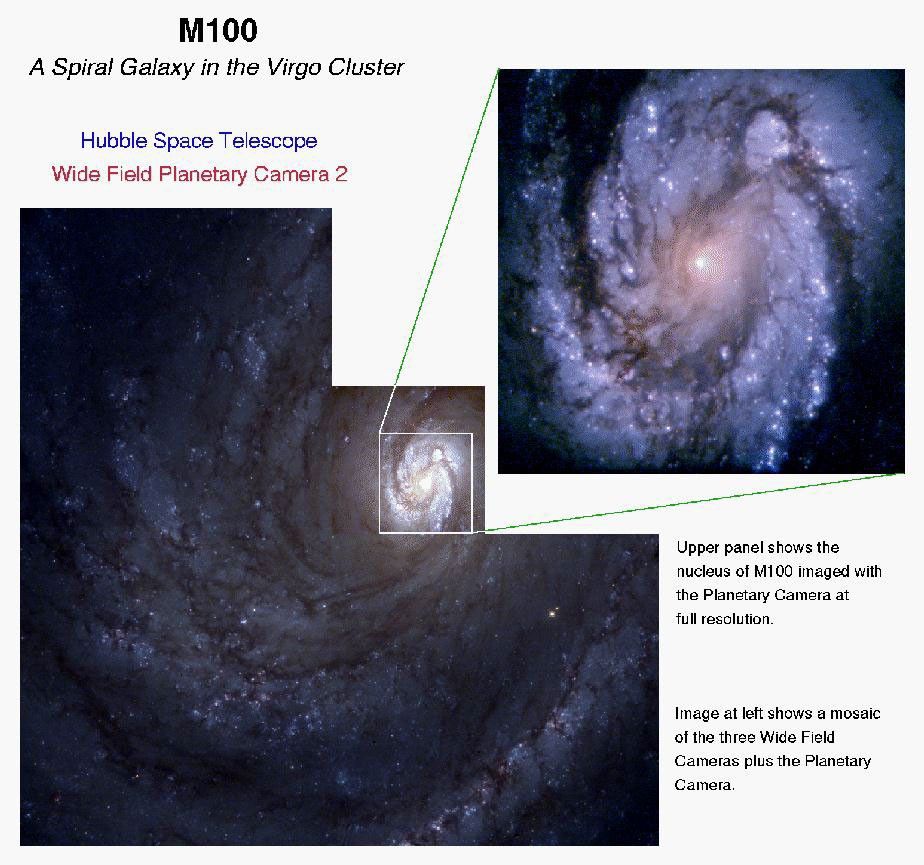1 min read
The Spiral Galaxy M100 as Seen With the Hubble’s Improved Vision

An image of the grand design spiral galaxy M100 obtained with the second generation Wide Field and Planetary Camera (WFPC-2), newly installed in the Hubble Space Telescope. Though the galaxy lies several tens of millions of light-years away, modified optics incorporated within the WFPC-2 allow Hubble to view M100 with a level of clarity and sensitivity previously possible only for the very few nearby galaxies that compose our "Local Group." Just as one does not learn about the diversity of mankind by conversing only with your next door neighbor, astronomers must study many galaxies in a host of different environments if they are to come to understand how our own galaxy, out star, and our earth came to be. By expanding the region of the universe that can be studied in such detail a thousand fold, the WFPC-2 will help the Hubble Space Telescope to fulfill this mission.
One of the greateset gains of the high resolution provided by Hubble is the Ability to resolve individual stars in other galaxies. The new camera not only allows astronomers to separate stars which would have been blurred together at the resolution available from the ground, but also allows astronomets to accurately measure the light form very faint stars. The quantitative study of compositions, ages, temperatures, and other properties of stars and gas in other galaxies will provide important clues about how galaxies form and evolve.
In addition, the WFPC-2 will allow the Hubble Space Telescope to be used to attack one of the most fundamental questions in science: the age and scale of the universe. Astronomers have many "yardsticks" for measuring the scale of the universe, but lack a good knowledge of how long these yardsticks really are. M100 is a member of the Virgo Cluster of galaxies. By allowing astronomers to resolve and measure individual stars in the Virgo Cluster - in particular a special type of star called Cepheid variables, which have well known absolute brightnesses - HST observations are expected to provide a crucial measurement of this much needed scale. (Only Space Telescope can make these types of observations. Cepheids are too faint and the resolution too poor, as seen from ground-based telescope, to separate the images in such a crowded region of a distance galaxy.)
The picture is chevron-shaped because it is a mosaic of the three wide field cameras and the planetary camera which make up the WFPC-2. The three wide field detectors in the camera reveal individual stars and filamentary dust lanes in the outer arms of the majestic spiral galaxy. The instrument's planetary camera image (upper right) resolved complex structure in the core of the galaxy, which is the site of vigorous star formation.
The image was taken on December 31, 1993. The field of view is about two and a half arc minutes across. The image aws taken through red, green, and blue filters to create a true color picture. Blue corresponds to the light from yound and massive stars that have recently formed along the spiral arms. The pinkish blobs are huge blouds of glowing hydrogen gas. They indentify sites of new star formation.
About the Object
- R.A. PositionR.A. PositionRight ascension – analogous to longitude – is one component of an object's position.12h 22m 54.94s
- Dec. PositionDec. PositionDeclination – analogous to latitude – is one component of an object's position.15° 49' 19.49"
- Object NameObject NameA name or catalog number that astronomers use to identify an astronomical object.M100, NGC 4321
- Release DateJanuary 13, 1994
- Science ReleaseThe Spiral Galaxy M100 as Seen With the Hubble’s Improved Vision
- Credit
Share
Details
Claire Andreoli
NASA’s Goddard Space Flight Center
Greenbelt, Maryland
claire.andreoli@nasa.gov

































